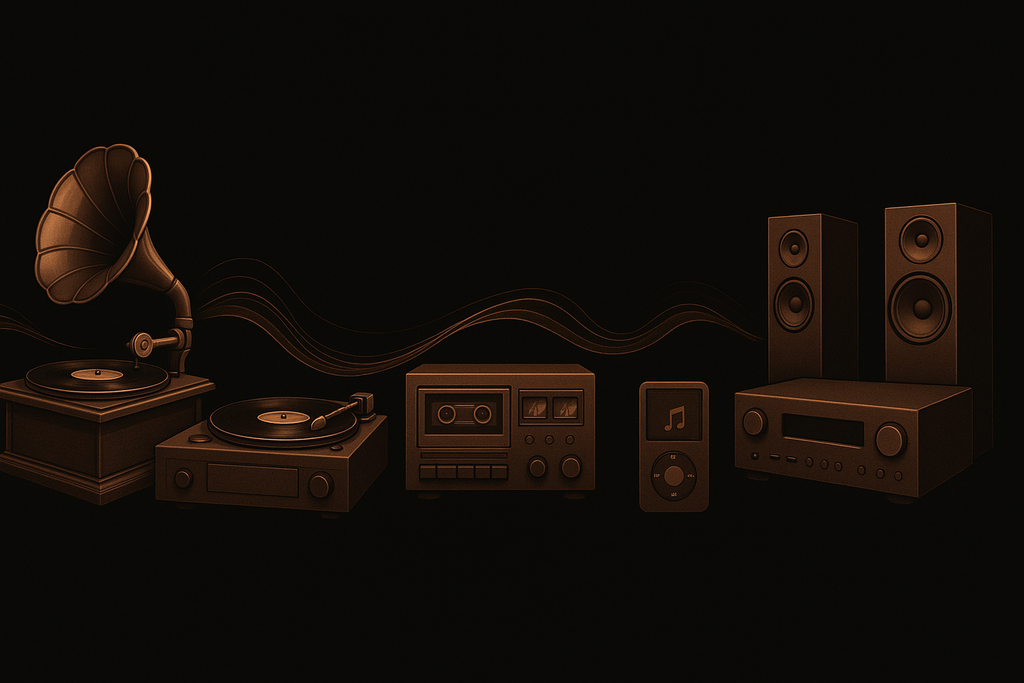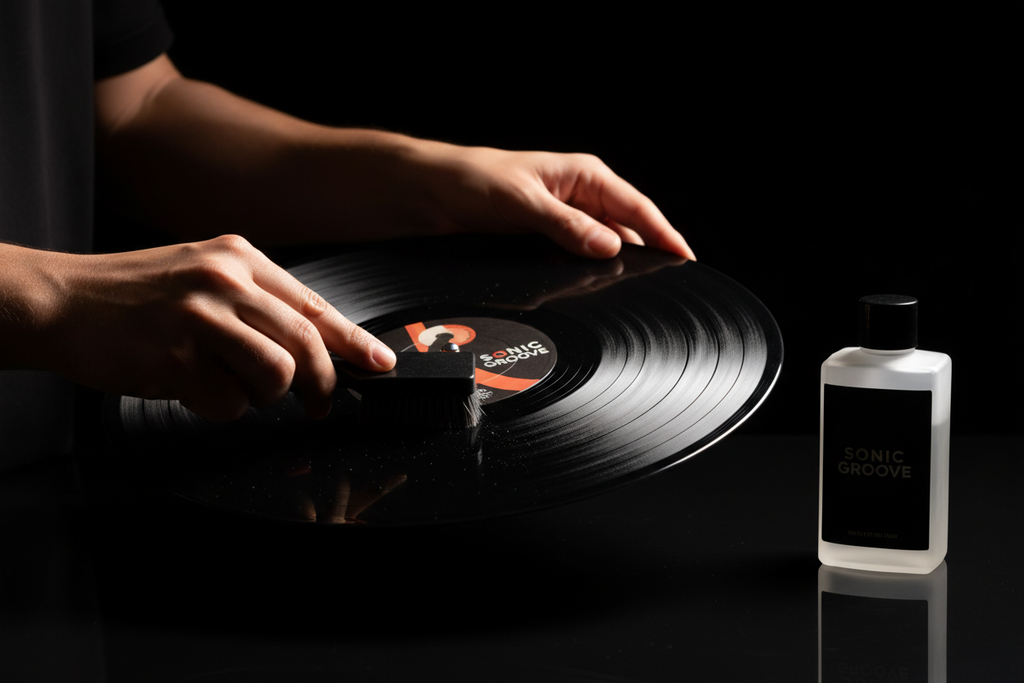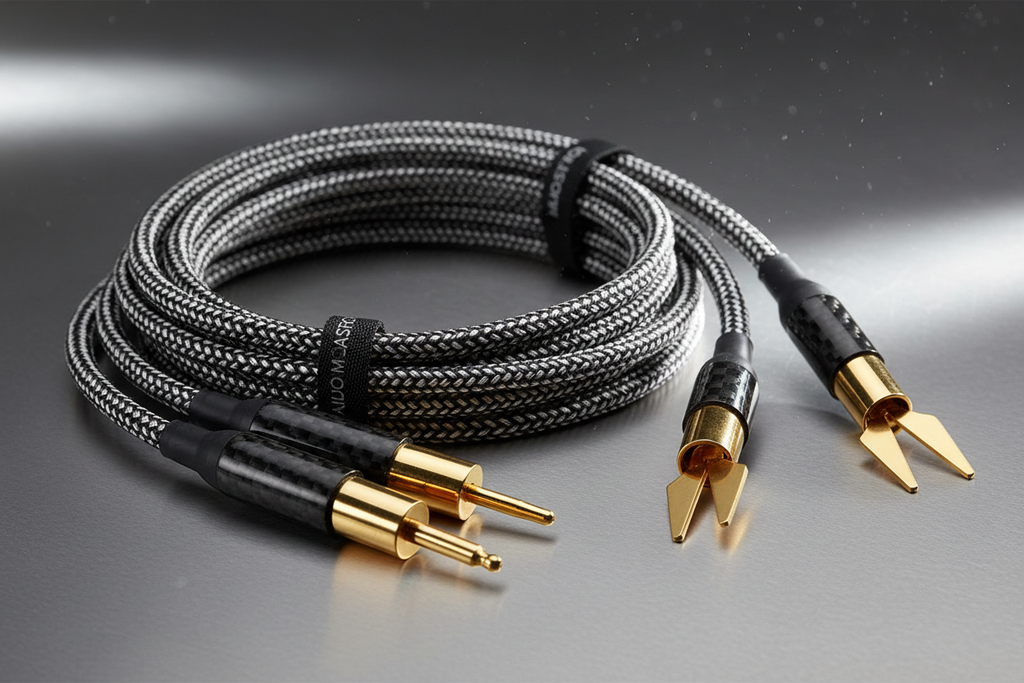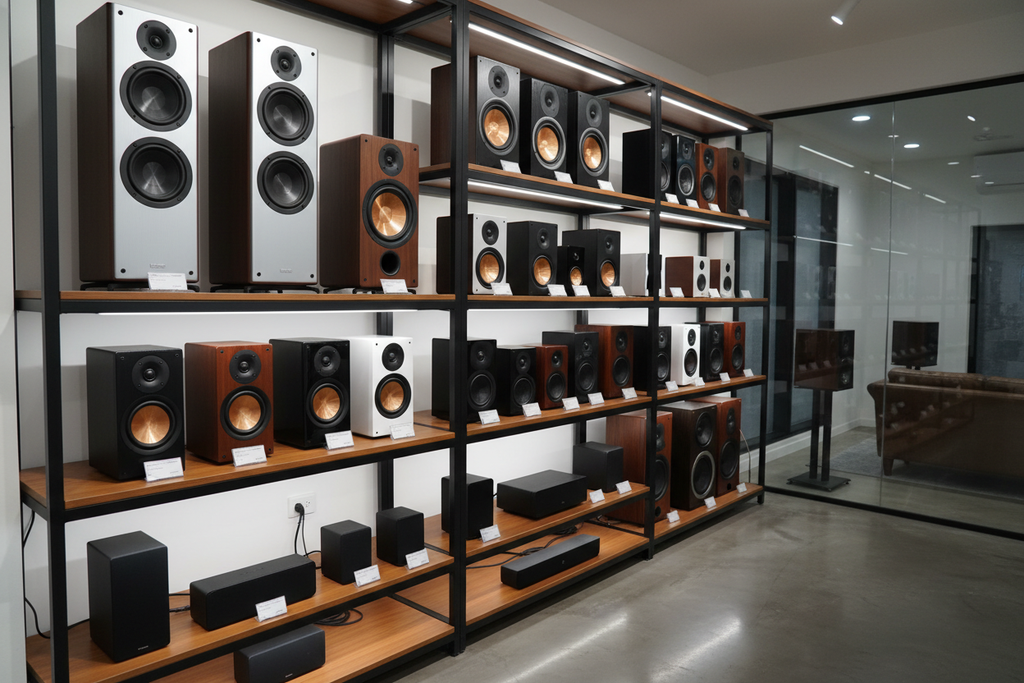
The Evolution of Audio - From Gramophones to Streaming Hi-Fi

The way we experience recorded sound has transformed dramatically over the past century. From the crackling mechanical playback of early gramophones to the crystal-clear convenience of modern streaming, each innovation has brought listeners closer to the music. This journey through audio history not only reflects technological progress but also the enduring quest for high fidelity (Hi-Fi) sound. Today, specialized HiFi store retailers (like SoundTrails, a premier HiFi store) offer enthusiasts a rich spectrum of audio gear from vintage turntables to cutting-edge streaming systems. Let’s explore how audio evolved from its humble beginnings to the era of streaming Hi-Fi.
Early Days: Phonographs and Gramophones

Twin horn gramophones, the iconic early home audio devices, which reproduced sound from flat discs by purely mechanical means. In 1877, Thomas Edison introduced the phonograph, a device that could record and play sound on tinfoil-wrapped cylinders. Edison’s phonograph astonished the world by capturing sound mechanically, but it was soon surpassed by Emile Berliner’s gramophone. In 1887, Berliner invented the gramophone, which played audio using flat discs instead of cylinders. This breakthrough made it easier to mass-produce recordings on discs (initially made of shellac). Gramophones with their 78 rpm shellac records became the standard for home music listening from the early 1900s through the 1940s. These early records could only hold a few minutes of audio per side, so listeners frequently had to change discs during an album or symphony. Despite their limitations (audible crackle, limited frequency range), the gramophone era marked the birth of the recorded music industry and brought music into living rooms for the first time.
As the technology matured, improvements followed. By the 1920s, electric microphones and amplifiers began replacing purely mechanical systems, boosting sound quality and volume. Radio broadcasting also emerged, allowing music to be enjoyed live over the airwaves. Even so, the gramophone and record player remained central to home entertainment. Companies like Victor and Columbia produced popular gramophones, and record labels flourished. Interestingly, some of today’s renowned HiFi brands have roots in this era - for example, Denon (founded in 1910) started out manufacturing gramophones and discs in Japan. This early period laid the foundation for an audio industry that would soon pursue higher fidelity and convenience.
The Vinyl Era and the Rise of High Fidelity

By the late 1940s, a major leap in audio quality arrived with the introduction of vinyl records. In 1948, Columbia Records unveiled the 33⅓ rpm Long Play (LP) vinyl record, and RCA Victor soon released the 45 rpm single. These vinyl discs were more durable than fragile shellac and boasted improved sound fidelity and longer playing time. An LP could hold about 20 minutes of music per side, enabling full albums and classical works to be enjoyed without constant interruption. This innovation coincided with the post-WWII economic boom and a growing public appetite for better sound. During the 1950s - often called the “Golden Age of Hi-Fi” – consumers enthusiastically embraced new high-fidelity record players and audio components. Manufacturers even began using the term “High Fidelity” as a marketing buzzword to signify equipment and recordings that delivered more faithful, realistic sound reproduction.
Stereo sound also emerged around 1957, adding a new dimension by splitting audio into left and right channels for a lifelike soundstage. Music lovers started upgrading from all-in-one victrolas to component-based Hi-Fi systems: separate turntables, amplifiers, tuners, and loudspeakers. Brands that are legends today were born or rose to prominence in this era. For instance, McIntosh Laboratory was founded in 1949 and became renowned for its high-performance amplifiers that defined premium American hi-fi sound. Speaker pioneers like Klipsch (founded 1946) and Wharfedale (founded 1932) introduced louder and clearer speakers, bringing concerts to living rooms. Even as vinyl records became the dominant medium for music, the quest for better sound continued – improved turntable designs, the use of vacuum tube amplifiers (valued for their warm sound), and advances in recording techniques all contributed to a richer audio experience. The vinyl era firmly established the album format and turned music listening into an activity worthy of high-quality home equipment. Companies such as Mobile Fidelity (MoFi) emerged later (in the 1970s) to cater to audiophiles by producing special high-fidelity vinyl pressings, a testament to vinyl’s enduring appeal among purists.
Portable Sound: The Tape and Cassette Revolution

The next big shift was not just about sound quality, but about portability and personalization. In the 1960s, Philips introduced the compact audio cassette, a small plastic cartridge containing magnetic tape. What cassettes lacked in fidelity compared to vinyl, they made up for in convenience: tapes were durable, easily portable, and could be recorded at home. The cassette let people create mixtapes – custom compilations of songs – which added a personal, intimate dimension to music sharing. By the 1970s and 1980s, cassettes had become hugely popular, aided by the invention of the Sony Walkman in 1979. The Walkman was a pocket-sized cassette player with headphones that allowed folks to take their music anywhere – jogging in the park or commuting on a bus. For the first time, music became truly mobile, and the personal stereo culture was born.
Earlier tape formats also played a role in audio’s evolution. Reel-to-reel magnetic tape decks, common in studios since the 1940s, had brought high fidelity recording capabilities (Bing Crosby and Les Paul famously used reel tape for better-sounding recordings). In the late 1960s, 8-track cartridges enjoyed a brief vogue, especially in car stereos, though they were eventually overtaken by cassettes. By the ’80s, a good Hi-Fi home setup often included a cassette deck alongside a turntable – allowing listeners to, say, record their vinyl albums or radio broadcasts onto tape for listening in the car or on the Walkman. HiFi enthusiasts could also buy pre-recorded cassettes of albums, though many still preferred the fuller sound of vinyl at home. The tape era proved that convenience and portability were powerful drivers of change in audio technology, even if purists were sometimes skeptical of the sound quality. Notably, companies like Denon and Nakamichi advanced cassette deck technology, with high-end models offering noise reduction (Dolby B/C) and exceptional fidelity for the format. The stage was set for the next revolution – one that would marry high fidelity with digital precision.
The Digital Revolution: Compact Discs and MP3s

In 1982, the launch of the Compact Disc (CD) ushered in the digital age of audio. Developed by Philips and Sony, the CD was a small optical disc that could store music digitally at a then-stunning 16-bit/44.1 kHz quality – delivering crystal-clear sound with no background hiss or pops. CDs offered superior sound quality and durability compared to vinyl and cassettes. They weren’t affected by scratches in the same way records were, and they never wore out from play (since laser reading is contact-free). By the late 1980s, CDs rapidly became the dominant music format, and millions of people replaced their record collections with shiny compact discs. Albums like Michael Jackson’s Thriller and Dire Straits’ Brothers in Arms became blockbusters in the new format, showcasing the CD’s wide dynamic range and clarity. For Hi-Fi stores, CD players and CDs themselves became essential stock, and brands like Sony, Philips, Denon(and later Marantz, which Denon merged with) competed to deliver the best-sounding CD players.
Digital audio also brought new possibilities. The perfect clarity of CDs demonstrated the benefit of eliminating analog imperfections. By the 1990s, digital technology shrank in size and cost, leading to the creation of compressed audio file formats. In the late 1990s, the MP3 format changed the game yet again. MP3 files could compress large audio data into relatively small files while maintaining reasonable sound quality, enabling music to be easily stored on computers and shared over the burgeoning internet. In 1999, the file-sharing service Napster appeared, allowing people to swap MP3 music files online – an event that shook the music industry to its core. Suddenly, a music collection was not a shelf of discs or tapes, but a folder on a computer or a pocket digital music player. This era saw a trade-off: listeners embraced the convenience of having thousands of songs in their pocket (on iPods and other MP3 players), but the audio was often lossy, meaning some fidelity was sacrificed to reduce file size. Nevertheless, digital downloads and MP3s became the new norm in the 2000s, with Apple’s iTunes Store (launched 2003) legitimizing online music sales and further solidifying digital audio’s dominance.
The Streaming Era: Instant Access Meets Hi-Fi Quality

If MP3s and iPods freed music from physical media, the next evolution freed music from ownership entirely. The streaming revolution took off in the late 2000s, spearheaded by platforms like Spotify (launched in 2008). Instead of buying individual songs or albums, users could now stream millions of tracks on-demand with a subscription or even for free (with ads). This model put an essentially infinite library of music in people’s hands, accessible anywhere there was internet. Services such as Spotify, Apple Music, Amazon Music, and YouTube Music have since become the primary way many people consume music. Streaming brought immense convenience and discovery – curated playlists, algorithmic recommendations, and social sharing of music. By the mid-2010s, streaming had overtaken physical sales and downloads to become the largest segment of the music industry. Initially, streaming services focused on accessibility and catalog breadth, often using compressed audio (similar to MP3 quality) to save bandwidth. However, as internet speeds improved and audiophiles voiced their demands, high-fidelity streaming options emerged. Tidal, launched in 2014, built its brand on offering lossless CD-quality streaming and even higher resolution audio for those who wanted it. In 2021, Apple Music rolled out a catalog-wide upgrade to lossless and high-resolution audio at no extra cost, bringing true hi-fi quality to mainstream streaming. Amazon Music and Qobuz likewise offer streams in 16-bit/44.1 kHz and beyond. Today, listeners can stream music in lossless FLAC or even 24-bit hi-res formats, getting sound quality on par with, or better than, CDs – all without any physical media. This means the convenience of streaming no longer requires sacrificing audio fidelity. Even Spotify has announced plans for a HiFi tier (as of 2025) to deliver lossless sound. For the first time, it’s possible to have both instant access to virtually all recorded music and audiophile-grade sound quality. That said, having high-quality streams is just one part of the hi-fi equation - the playback equipment matters greatly. This is where modern HiFi stores and brands come into play, ensuring that the digital clarity of streaming can be fully experienced.
The Modern Hi-Fi Experience and Audio Brands Today

A modern high-fidelity loudspeaker with multiple drivers (woofer, midrange, tweeter, etc.) ensures each frequency band is reproduced with clarity and depth - a key to realistic sound. In the 2020s, we truly have the best of both worlds: the ease of digital streaming and the option of high-end analog and digital equipment to reproduce sound as richly as possible. Audiophiles can stream a studio-quality album to a network-enabled Hi-Fi system and enjoy a level of fidelity unimaginable in the gramophone days. The market is filled with HiFi audio brands that cater to every aspect of the listening experience. Many of these brands have storied legacies bridging past and present. For example, MoFi (Mobile Fidelity Sound Lab), known for its audiophile vinyl pressings and now turntables, thrives on the vinyl resurgence by providing that warm analog sound to a new generation. Sonus Faber (founded 1983 in Italy) handcrafts beautiful high-end speakers that are as much art pieces as audio devices, continuing a tradition of fine sound and design. McIntosh, an American brand from the 1950s, still produces its legendary amplifiers (with those iconic blue VU meters) to drive modern speaker systems with power and purity. On the other end of the spectrum, Sonos represents the convergence of hi-fi with smart technology – their wireless multi-room speakers make it simple to stream music throughout your home, yet with impressive sound quality and convenience. There are also brands like Edifier and XTZ offering affordable yet decent hi-fi speakers for budding enthusiasts, and venerable names like Dali, Fyne Audio, Klipsch, and Denon continuing to innovate based on decades (or even a century) of audio expertise.
Crucially, having knowledgeable retailers is important for navigating this rich landscape of hi-fi options. SoundTrails, for instance, is a specialized HiFi store online (and an authorized dealer for many top brands) that helps music lovers build their dream audio setups. Stores like this curate a selection of the best from multiple brands – whether it’s a MoFi turntable for your vinyl collection, a pair of Sonus Faber or Klipsch speakers for immersive sound, a McIntosh amplifier for that smooth power, or the latest streaming DAC (Digital-to-Analog Converter) to get the most out of high-res digital music. By offering equipment from multiple hi-fi brands such as MoFi, Sonus Faber, McIntosh, Sonos, Edifier, Fyne Audio, Dali, Denon, XTZ, Klipsch and many more, a HiFi store ensures that customers can find the perfect match for their audio preferences and budget. Being an authorized dealer means they provide genuine products with full warranty, which is vital given the investment-quality of high-end audio gear.
As we stand today, the evolution of audio has come full circle in some ways. The goal has always been to make the reproduced sound as lifelike as the original performance – fidelity to the source. Early inventors like Edison and Berliner took the first steps, and each subsequent technology (vinyl, tape, CD, digital, streaming) has brought us closer to that goal while adding new conveniences. We now live in an age where you can cue up virtually any song ever recorded in seconds, in high fidelity, and hear details that might even surpass the quality of older formats. Yet, we also continue to cherish legacy formats like vinyl records for their tangible charm and unique sound character. Audiophiles can have a foot in both worlds: spinning a classic LP on a quality turntable one moment, and the next moment streaming a hi-res album from the cloud – with both delivered through the same finely tuned hi-fi system.
In conclusion, the journey from gramophones to streaming hi-fi is a story of innovation, improving quality, and increasing convenience. It reflects our timeless passion for music and the desire to hear it the way it was meant to be heard. Modern HiFi stores like SoundTrails celebrate this legacy by equipping enthusiasts with the best tools from every era of audio - be it a vintage-style tube amplifier or a cutting-edge wireless speaker. As technology continues to advance, one thing remains true: great sound never goes out of style. The crackle of an old record and the bit-perfect stream of a new digital track are just two points on the same continuum, and each milestone in the evolution of audio has enriched our listening lives. Sound quality has never been more accessible, and as we enjoy today’s hi-fi streaming or classic analog tunes, we carry forward a rich heritage of audio innovation into the future.






